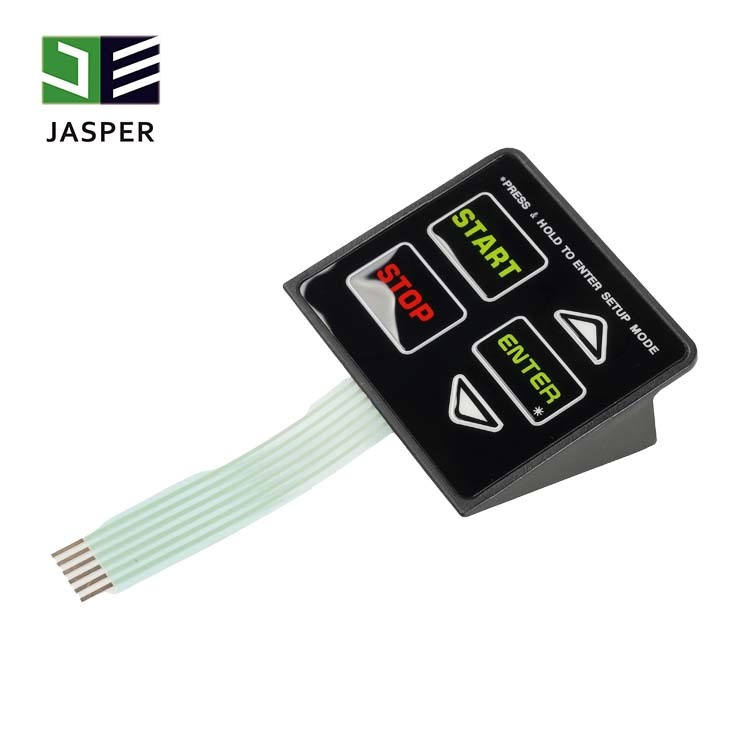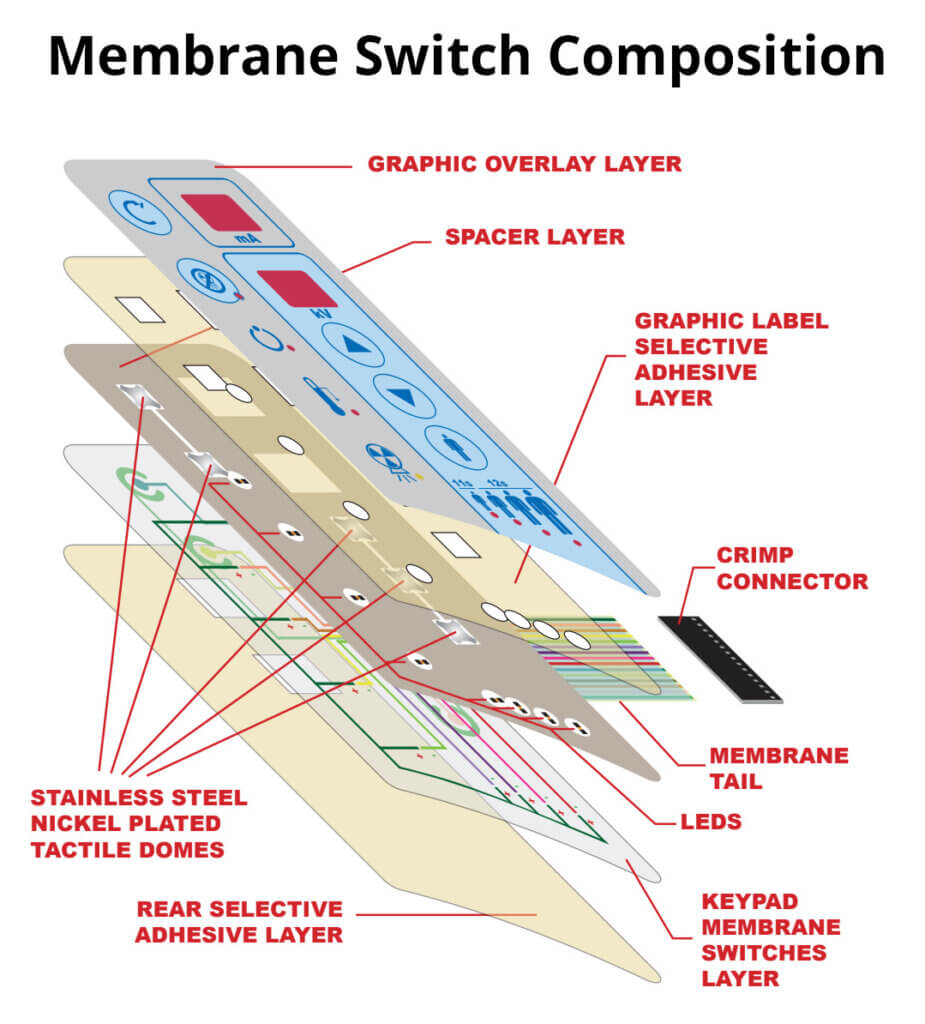Global Membrane Switch Manufacturer with Scalable Production Options
Global Membrane Switch Manufacturer with Scalable Production Options
Blog Article
Exploring the Production Refine of Membrane Switch for Various Industries
The production procedure of Membrane buttons is a complex endeavor that requires precision and attention to detail. From picking ideal products to carrying out strenuous quality assurance procedures, each step plays an important function in guaranteeing functionality. Various markets, including medical and automotive, count on these parts for their special applications. Understanding the complexities of this process reveals considerable insights right into just how these switches are created and their impact throughout diverse industries.
Comprehending Membrane Changes: A Review

Key Products Made Use Of in Membrane Switch Production
In Membrane switch production, the option of key products substantially influences capability and toughness. Conductive products, adhesives, and layers play vital functions, while substratum choice influences general efficiency and dependability. Understanding these parts is vital for enhancing the design and manufacturing of Membrane switches.
Conductive Products Overview
Conductive materials play an essential role in the performance of Membrane switches, guaranteeing reputable electrical links within the tool. Typically made use of products include silver, copper, and carbon-based inks, each offering unique benefits. Silver is preferred for its high conductivity and durability, making it suitable for applications requiring robust performance. Copper, while somewhat much less conductive than silver, is a cost-efficient alternative typically made use of in published circuits. Carbon-based inks provide a versatile choice, appropriate for applications where versatility and reduced expenses are focused on, although they have actually reduced conductivity compared to steel choices. The option of conductive products straight impacts the overall reliability, lifespan, and efficiency of the Membrane switch, making it an important factor to consider in the production procedure.
Adhesives and Coatings
Adhesives and finishings are important components in the production of Membrane buttons, providing essential bonding and protective buildings. These products assure that various layers of the button, consisting of visuals overlays and circuitry, adhere securely to one an additional, boosting toughness and functionality. Generally made use of adhesives consist of pressure-sensitive adhesives (PSAs) and epoxy-based formulas, which use solid bond and strength. Coatings, such as polyurethane or acrylic, serve to shield versus ecological aspects, consisting of wetness, abrasion, and chemicals. Additionally, finishings can improve responsive feedback and aesthetic charm, contributing to the general individual experience. The selection of appropriate adhesives and finishings is essential for maximizing efficiency and longevity in diverse applications throughout different industries, ensuring that Membrane switches over fulfill particular operational needs.
Substrate Choice Aspects
Substrate choice plays a necessary duty in the production of Membrane buttons, as it greatly influences their overall efficiency and sturdiness. Key products such as polyester, polycarbonate, and adaptable published circuit boards (FPCBs) are frequently made use of for their distinct buildings. Polyester is favored for its cost-effectiveness and resistance to abrasion, making it appropriate for applications with high wear. Polycarbonate offers superior clarity and influence resistance, suitable for settings requiring high exposure. FPCBs offer improved versatility and are usually used in intricate layouts. The selection of substratum additionally affects elements like thermal stability, chemical resistance, and ease of printing. Ultimately, choosing the suitable substratum is critical for making certain the functionality and longevity of Membrane changes throughout numerous sectors.
The Style Refine of Membrane Switches Over
The layout procedure of Membrane switches is an essential stage that greatly influences the capability and aesthetic appeals of the end product - membrane switch manufacturer. It begins with defining the certain demands of the application, including dimensions, button layout, and responsive responses choices. Designers must think about individual interaction, ensuring that the switch is instinctive and accessible.Next, materials are selected based on toughness, adaptability, and environmental resistance. The combination of graphics and branding aspects is likewise necessary, as it boosts visual appeal and interaction. Prototyping permits repetitive screening, making it possible for changes based on individual feedback and performance evaluations.Additionally, the layout has to represent the electrical components, such as circuits and ports, making certain dependability and convenience of use. Ultimately, a successful layout integrates capability, aesthetics, and customer experience, leading the method for reliable manufacturing and long-lasting efficiency in different sectors
Printing Techniques for Membrane Switches
The printing strategies used in Membrane button manufacturing play an essential role in determining the end product's top quality and performance. Screen printing offers benefits such as resilience and vivid shade application, while digital printing advancements offer adaptability and precision in design. Comprehending these methods can substantially impact the general effectiveness of Membrane buttons in different applications.
Display Printing Benefits
Various benefits make screen publishing a recommended technique for creating Membrane switches. This technique permits top quality, comprehensive designs and dynamic shades, which are crucial for user interface applications. Screen printing is specifically reliable for using thick ink layers, improving durability and responsive feedback. In addition, it offers excellent bond to various substrates, making sure long life sought after environments. The procedure is cost-efficient for big manufacturing runs, as it lessens configuration time and waste. Screen printing sustains a broad variety of inks, consisting of specialty and UV-curable options, enabling convenience in layout. Its capacity to generate constant results across numerous units makes it a trustworthy option for manufacturers going for top quality and efficiency in Membrane button manufacturing.
Digital Printing Innovations

Improvements in digital printing modern technology are changing the production of Membrane buttons, providing makers ingenious options that boost design adaptability and efficiency. Digital printing allows for intricate styles and high-resolution graphics, making it possible for personalized branding and performance without the limitations of typical methods. This method minimizes arrangement times and prices, assisting in shorter manufacturing runs and marginal waste, making it suitable for businesses with varying needs. Additionally, developments in ink solutions offer better resilience and adhesion, making certain longevity in different environments. As sectors increasingly seek customized and intricate designs, electronic printing stands out as an important technique, setting a brand-new criterion in Membrane switch production. The combination of these technologies positions producers to satisfy progressing market requires efficiently.
Assembly and Layering of Membrane Switch Components
Cautious assembly and layering of Membrane button components are important to assuring capability and longevity. This process begins with the precise positioning of numerous layers, consisting of the graphic overlay, glue, circuit layer, and support material. Each part needs to be meticulously placed to maintain electrical integrity and interface responsiveness.During setting up, conductive traces are applied to the circuit layer, commonly made from products like polyester or polycarbonate. This layer is crucial, as it beams when stress is applied. The adhesive made use of for bonding these layers is additionally chosen for its capacity to withstand ecological anxieties while keeping a safe and secure bond.Heat and pressure are often used throughout the setting up procedure to ascertain that the layers stick correctly without endangering the capability of the button. Lastly, interest is offered to the edge sealing to safeguard against dampness and contaminants, securing the longevity of the Membrane switch in various industrial applications.
Top Quality Control Actions in Membrane Switch Production
Quality control steps play an essential function in guaranteeing the integrity and efficiency of Membrane switches following the assembly and layering of their elements. In the production my response procedure, several essential evaluations are carried out to maintain top quality standards. These include aesthetic evaluations for problems in printing and sticky application, along with useful examinations to verify the responsiveness of each switch.Additionally, environmental screening is done to examine the buttons' toughness versus temperature changes and moisture direct exposure. Suppliers frequently execute analytical procedure control (copyright) techniques to keep track of production consistency, enabling early detection of anomalies.Furthermore, traceability systems are developed to track elements and products, ensuring accountability and facilitating remembers if needed. Calibration of tools and adherence to industry requirements are additionally essential to maintaining item honesty. Collectively, these quality assurance measures secure the performance of Membrane switches over across numerous applications, eventually enhancing client satisfaction.
Applications of Membrane Switches Over Across Different Industries
Membrane buttons are made use of across a varied variety of sectors, showcasing their convenience and versatility. In the medical field, they supply water resistant and dependable user interfaces for devices such as analysis equipment and mixture pumps, making sure health and convenience of usage. The why not try here automotive market uses Membrane switches for control panel controls, making it possible for smooth interaction in between the vehicle driver and vehicle systems.In customer electronic devices, these switches are located in home appliances and portable gadgets, offering a sleek, contemporary visual while improving performance. Industrial applications additionally take advantage of Membrane switches over for machinery control panels, where resilience and resistance to extreme conditions are essential.Furthermore, the aerospace and defense fields use Membrane switches for cockpit instrumentation and communication systems, focusing on integrity and efficiency under extreme conditions. In general, Membrane switches play an essential function in improving the individual experience and operational effectiveness throughout numerous domain names.
Often Asked Inquiries
Exactly how Lengthy Does It Require To Manufacture a Membrane Switch?
The production time for a membrane layer switch normally varies from a few days to several weeks - membrane switch manufacturer. Aspects influencing this period include style complexity, product schedule, and manufacturing volume, all affecting the general timeline considerably
What Is the Typical Lifespan of a Membrane Switch?
The regular life-span of a membrane switch usually varies from 1 to 5 million actuations, depending upon elements such as material high quality, environmental problems, and use frequency, significantly impacting longevity and overall efficiency.
Can Membrane Switches Over Be Customized for Details Applications?
Membrane buttons can certainly be customized for particular applications. Their design versatility permits alterations in size, form, shades, and graphics, making certain compatibility with special requirements across different markets and boosting functionality and customer experience.

Are Membrane Switches Eco-friendly?
The ecological influence of Membrane changes varies. Some products utilized might not be environment-friendly, while developments in manufacturing processes are progressively concentrating on sustainability, aiming to decrease waste and advertise recyclable parts in their production.
What Are the Usual Failing Modes of Membrane Switches?
Common failure settings of Membrane switches consist of delamination, glue failure, deterioration from usage, wetness ingress, and electrical failings. These issues can considerably impact performance, performance, and life expectancy in various applications throughout various industries. Membrane switches can be customized to fit particular style needs, such as shape, performance, and size, making them extremely adaptable.The building and construction typically includes several layers, including a visuals overlay, sticky, and a circuit layer, which work together to develop a seamless individual experience. In Membrane switch manufacturing, the choice of vital materials greatly affects capability and longevity. The auto market employs Membrane buttons for control panel controls, enabling check out here smooth communication between the chauffeur and vehicle systems.In consumer electronics, these switches are found in home appliances and handheld tools, providing a streamlined, contemporary aesthetic while boosting functionality. Industrial applications additionally utilize Membrane switches over for equipment control panels, where resilience and resistance to extreme problems are essential.Furthermore, the aerospace and defense fields utilize Membrane switches for cockpit instrumentation and interaction systems, prioritizing integrity and performance under severe conditions. Membrane switches can certainly be personalized for particular applications.
Report this page